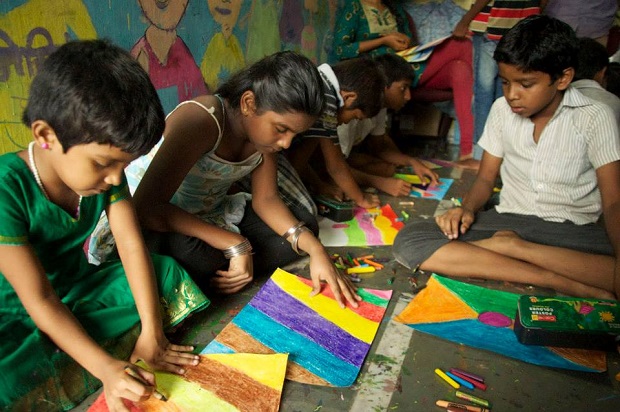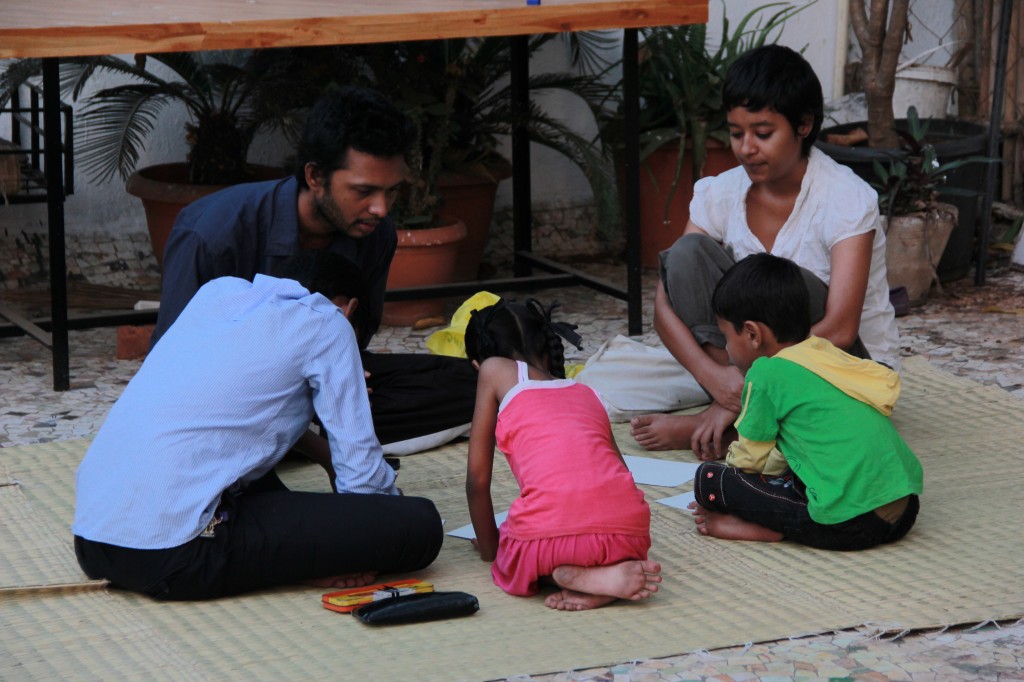The multitude of humanity that make up the lifeline of Dharavi are always at work. The world’s largest slum, housed in Mumbai, has been overtly romanticized by tourists, locals and the media at largest. The population density here, according to some reports, is approximately 11 times more than any other part of the city. The leather tanning, pottery, handicrafts, and multiple industries dictate this hustling, bustling, industrial, and strangely dangerous tone to the location. But these are all numbers and figures that The Dharavi Art Room doesn’t really care too much about: what matters to them are the human beings, the women and children that affect the place in the way they do and creating a connect between this “section” and “us” so that both can benefit from it.
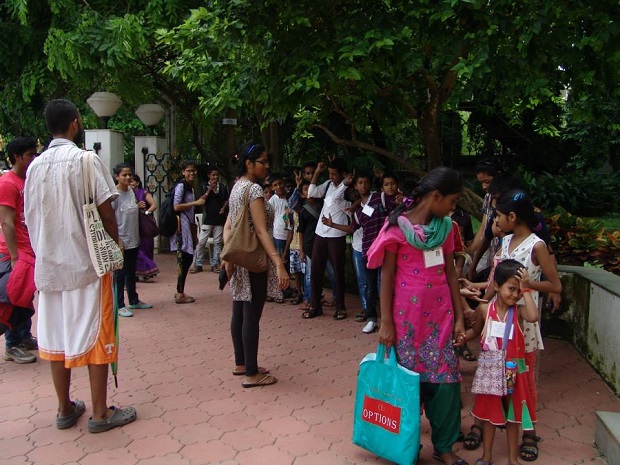
Dharavi Art Room Takes The Kids To Nehru Center For An Excursion.
Courtesy: Dharavi Art Room
The Dharavi Art Room is a two-member team of Himanshu S and Aqui Thami, who have made it a creative haven for the children from the area. It’s a simple structure that the concept works on: spreading art in its simplest form, developing life skills that not only keep individuality but community kicking, and encouraging life stories that would lead to holistic growth for all members involved, and beyond. As Himashu explains “The lives of children from Dharavi is not very different from those of children otherwise. They face the same tensions, the same family issues, and the same anxieties of children from other places across the city. However, their ability to translate these things into positives is lesser, giving the lack of opportunity.” Aqui adds, “When kids from the other parts of the city are growing, they join art classes, or learn music, or even different sports. The kids at The Dharavi Art Room usually don’t get a go at these activities, and our aim is to give them that chance to explore more than they would otherwise. One such outdoor activity being taking the children to places like Maharastra Nature Park and Nehru Center”.
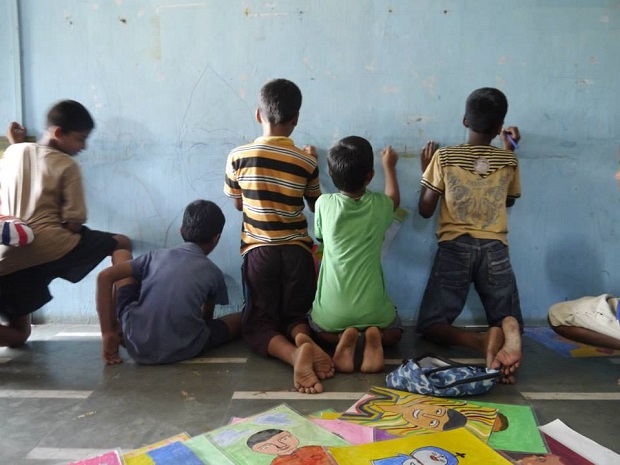
Courtesy: Dharavi Art Room
The Dharavi Artroom used to be a physical space before, a rented room where all of the children’s activities would take place. Funding however, was always tight, and eventually, the place had to be given up. But it’s mighty difficult to pull the plug on activities as lively and as beautiful as growing community on a whole. The Dharavi Art Room moved from being a physical space to a concept, where whatever space is available for use for activities is utilized. While one particular week the activities might be in the temple complex, the next it might be within a residential complex, so organic in fact the group is, that you’d possibly see the tribe of children attending sessions only increasing time after time.
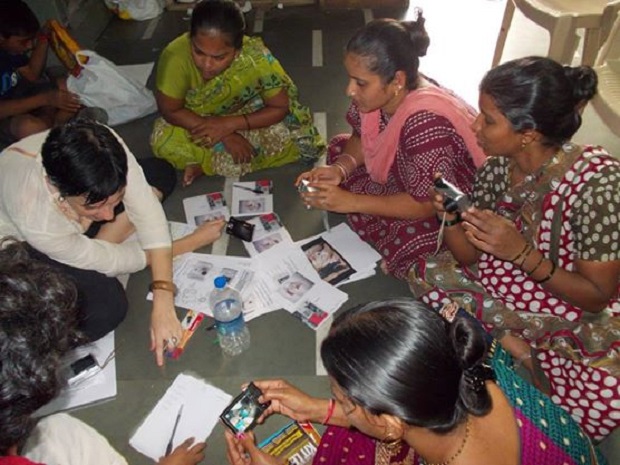
Courtesy: Dharavi Art Room
The Dharavi Art Room also work with women from Dharavi, giving them the opportunity to take a break from their families and other responsibilities, and that’s something that they have never done in the lives. Aqui says “These women would never get out of their homes, so when they come for our sessions, it makes them feel much better about life in general”.Himanshu makes a very interesting point when he explains why Dharavi is the way it is. “A lot of people see Dharavi through their own eyes instead of the eyes of the people that exist and live there. If they only did the latter, they’d see that it’s to a large degree their own ways of living that make Dharavi what it is. We think that Dharavi is a dirty place, but a large part of the waste there is also what comes from surrounding places like Mahim and Bandra.” But that’s not the main concern here. The real question is whether people who come from other places even connect with the people from Dharavi as a part of a collective community. To quote Aqui Thami, “The Dharavi Art Room wants to bring children and women from Dharavi into understanding opportunity better through art and storytelling, and at the same time, bring to them the joy of community activities and art for the sake of recreation and enjoyment, as opposed to only achieving financial benefits out of it.”
Case in point, the is Dharavi Direct exhibition on at The Hive, Khar currently. All across the place are photographs clicked by children from Dharavi, with the most basic of camera training, but the images they click are spellbinding. An excited Aqui Thami pipes in “You could go around looking at all the photographs and you won’t find a single one that is not brilliant. Just like all other kids, these kids are super inquisitive, and given a camera, they are click happy!” Himanshu continues “The first two or three days of the twenty day photography camp, we just let them click whatever they want, since that is pure excitement. Once that excitement dwindles a bit, they settle down into understanding the art better.” Not before two or three camera are lost to inquisitiveness or mishandling, but that’s okay. Quite understandably, The Dharavi Art Room is always scouting for people wanting to give their old digital cams away. Also at the exhibition are a host of books and postcards inspired by art from Dharavi, as well as showcasing their talent. These books are all on sale, and proceeds from sales go towards the running of The Dharavi Art Room itself.
The Dharavi Art Room has not stuck to the one location though; they have also expanded to seven BMC-run schools, plus a low income school in Dharavi itself. Their latest venture has been a free school for the children from Chuim Village, where The Hive is located. Every Tuesday evening, children from the locality bustle in, excitement on faces and happiness manifest in the minimum one hour that they spend there. Himanshu says “The kids here return home from school by 6PM, but are on the terrace by 6.15 PM. We are sure some of them don’t even eat a snack before coming.” That kind of excitement only magnifies the children’s interest in being part of something arty. And we can see why!
- You can connect with Dharavi Art Room, by clicking here. For details about the Dharavi Direct exhibition at The Hive, click here.
